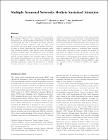| dc.contributor.author | GARAVAN, HUGH PATRICK | |
| dc.date.accessioned | 2008-11-19T17:06:22Z | |
| dc.date.available | 2008-11-19T17:06:22Z | |
| dc.date.issued | 2003 | |
| dc.date.submitted | 2003 | en |
| dc.identifier.citation | Lawrence, N., Ross, T., Hoffman, R., Garavan, H., Stein, E.A. `Activation and deactivation during the rapid visual information processing task: an fMRI study? in Journal of Cognitive Neuroscience, 15, 2003, pp 1028 - 1038 | en |
| dc.identifier.other | Y | en |
| dc.identifier.uri | http://hdl.handle.net/2262/24883 | |
| dc.description | PUBLISHED | en |
| dc.description.abstract | Sustained attention deficits occur in several neuropsychi-
atric disorders. However, the underlying neurobiological
mechanisms are still incompletely understood. To that end,
functional MRI was used to investigate the neural substrates
of sustained attention (vigilance) using the rapid visual
information processing (RVIP) task in 25 healthy volunteers.
In order to better understand the neural networks under-
lying attentional abilities, brain regions where task-induced
activation correlated with task performance were identified.
Performance of the RVIP task activated a network of frontal,
parietal, occipital, thalamic, and cerebellar regions. Deactiva-
tion during task performance was seen in the anterior and
posterior cingulate, insula, and the left temporal and
parahippocampal gyrus. Good task performance, as defined
by better detection of target stimuli, was correlated with
enhanced activation in predominantly right fronto-parietal
regions and with decreased activation in predominantly left
temporo-limbic and cingulate areas. Factor analysis revealed
that these performance-correlated regions were grouped into
two separate networks comprised of positively activated and
negatively activated intercorrelated regions. Poor performers
failed to significantly activate or deactivate these networks,
whereas good performers either activated the positive or
deactivated the negative network, or did both. The fact that
both increased activation of task-specific areas and increased
deactivation of task-irrelevant areas mediate cognitive func-
tions underlying good RVIP task performance suggests two
independent circuits, presumably reflecting different cogni-
tive strategies, can be recruited to perform this vigilance
task. | en |
| dc.format.extent | 1028 | en |
| dc.format.extent | 1038 | en |
| dc.format.extent | 192613 bytes | |
| dc.format.mimetype | application/pdf | |
| dc.language.iso | en | en |
| dc.publisher | MIT Press | en |
| dc.relation.ispartofseries | Journal of Cognitive Neuroscience | en |
| dc.relation.ispartofseries | 15 | en |
| dc.rights | Y | en |
| dc.subject | Psychology | en |
| dc.title | Activation and deactivation during the rapid visual information processing task: an fMRI study. | en |
| dc.type | Journal Article | en |
| dc.type.supercollection | scholarly_publications | en |
| dc.type.supercollection | refereed_publications | en |
| dc.identifier.peoplefinderurl | http://people.tcd.ie/garavanh | |
| dc.identifier.rssinternalid | 6404 | |




